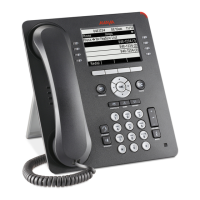Administration Overview and Requirements
18 Deskphone SIP 9608, 9611G, 9621G, 9641G Administrator Guide Release 6.0.1
The conditions under which the 9600 Series SIP deskphones need to operate are summarized
as follows:
●
Telephone Administration on the Communication Manager (CM) call server, as covered in
Chapter 4:
Avaya Aura
®
Communication Manager Administration.
●
Administration on either SIP Enablement Services (SES), as covered in Chapter
5: Administering Avaya Aura
®
SIP Enablement Services (SES), Session Manager, and
System Manager (SM) or administration ‘on Avaya Aura
®
Session Manager (SM), as
covered in Administering Avaya Aura
®
Session Manager (Document Number 03-603324).
●
IP Address management for the deskphone, as covered in Chapter 6: Server
Administration for dynamic addressing. For static addressing, see the Avaya one-X™
Deskphone SIP Installation and Maintenance Guide for 9608, 9611G, 9621G, and 9641G
Deskphones (Document Number 16-603604).
●
Tagging Control and VLAN administration for the deskphone, if appropriate, as covered in
Chapter 8:
Administering Telephone Options.
●
Quality of Service (QoS) administration for the deskphone, if appropriate. QoS is covered
in QoS
on page 37 and Administering QoS on page 50.
●
Protocol administration, for example, Simple Network Management Control (SNMP) and
Link Layer Discovery Protocol (LLDP).
●
Interface administration for the deskphone, as appropriate. Administer the deskphone to
LAN interface using the PHY1 parameter described in Chapter 3:
Network Requirements.
Administer the deskphone to PC interface using the PHY2 parameter described in
“Interface Control” in the Avaya one-X™ Deskphone SIP Installation and Maintenance
Guide for 9608, 9611G, 9621G, and 9641G Deskphones (Document Number 16-603604).
●
Application-specific deskphone administration, if appropriate, as described in Chapter
8: Administering Telephone Options. An example of application-specific data is
Web-specific information required for the optional Web browser application. Note that
optional Web browser capabilities are not available for the four deskphone models
covered by this release.
Administration alternatives and options
indicates that you can administer system configuration
parameters in a variety of ways and use the following administrative mechanisms:
●
Maintaining the information on the call server.
●
Manually entering the information by means of the deskphone dialpad using Craft (local
administrative) procedures. Craft procedures are described in "Chapter 3: Local
Administrative Options" in the Avaya one-X™ Deskphone SIP Installation and
Maintenance Guide for 9608, 9611G, 9621G, and 9641G Deskphones (Document Number
16-603604).
●
Administering the DHCP server.
●
Editing the configuration file on the applicable HTTP or HTTPS file server.
●
User modification of certain parameters, when given administrative permission to do so.

